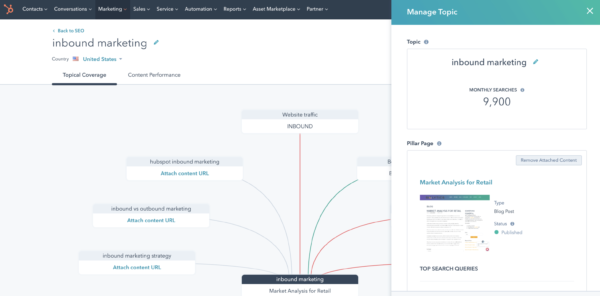
You may have been hearing about them a lot lately: But what is a topic cluster, anyway?
A topic cluster is a series of digital content that is published on your website and covers a specific topic, usually a keyword target. A topic cluster (also known as a content cluster) helps structure your articles for search engine optimization, or SEO.
In this post, we’ll show you why topic clusters matter for many B2B marketing objectives like lead generation, and how to be successful with your content strategy.

Search engine optimization, or SEO, is the process of getting your website to “rank” for specific search terms in Google and other search engines. This way, you can be found by potential leads online when they start a buying process. So ranking for terms related to your business is critical in order to generate leads online.
In the not too distant history of SEO, marketers focused on keywords, or highly searched phrases, to drive their content strategies. They would usually write one article per keyword, then move onto the next. However, Google is getting smarter and now gives priority to websites that show wider knowledge and topic authority. So, simply publishing one article -- being a “one hit wonder” -- often isn't enough to help you rank.
That’s where topic clusters come in: Topic or content clusters represent the strategy of building many published pages and articles around the same keyword-optimized topic.
The cluster strategy also helps you avoid having duplicate or competing pages around the same topic, since competing pages aren't good for search engine optimization.
Topic clusters are as important for B2B as any other business. In fact, at Ironpaper we've doubled the organic search lead generation rate for B2B businesses using a topic cluster strategy.
Here are the major things you can achieve with a topic-based content strategy:

A topic cluster usually has an SEO page or other important website page at the center. This is the "final destination" where you want to drive new leads. So this central page should have three things:
In addition to your central destination page, you should think of adding more content, most often blog articles, to push links back to the central page. (Think of a visual of many spokes on a wheel pointing back to the central hub.)
Each blog article should be optimized for SEO with a keyword variation and modifiers, making it what we call “long tail.”
Each blog post should also include a hyperlink somewhere to your central SEO page. This link give Google a hint to the relationship of your pages, like handing over a roadmap. You're saying, here is the most important page for this term across my website.
In addition to the best practices for topic clusters that we outlined above, there are a few more things you need to do to be successful and see positive results:
Topic clusters help B2B businesses more precisely generate leads that are a match for their business. Use clusters to structure both your content plan and your keyword linking strategy -- and make sure to follow the best practices for your wider SEO plan.
by Jonathan Franchell, CEO of Ironpaper - For more tips and hacks: Need to remove a new line after h1 tags? Both web designers and SEO practitioners need to employ headline tags: H1, H2, H3 in several ways to improve web page structure and tag...

The Crowded Arena of the IT Marketplace Updated December 2024 The Information Technology (IT) landscape is experiencing rapid growth and intensifying competition. IT spending is projected to reach nearly 5.1 trillion U.S. dollars in 2024, a...

The marketing industry is transforming significantly due to generative AI and increasing market complexity. Gartner's prediction of a 25% decline in traditional search traffic suggests that the era of search engines is dying. AI tools, particularly...

Updated December, 2024 The field of digital marketing is evolving rapidly in response to new technology and changing buyer expectations. To help career-minded marketers, we’ve rounded up the top 10 skills needed to succeed in the field. These are...
